Passenger cars
Field-proven bespoke hybrid fluids
09 July 2024
14 December 2016
Modern engines demand next generation viscosity modifier technology
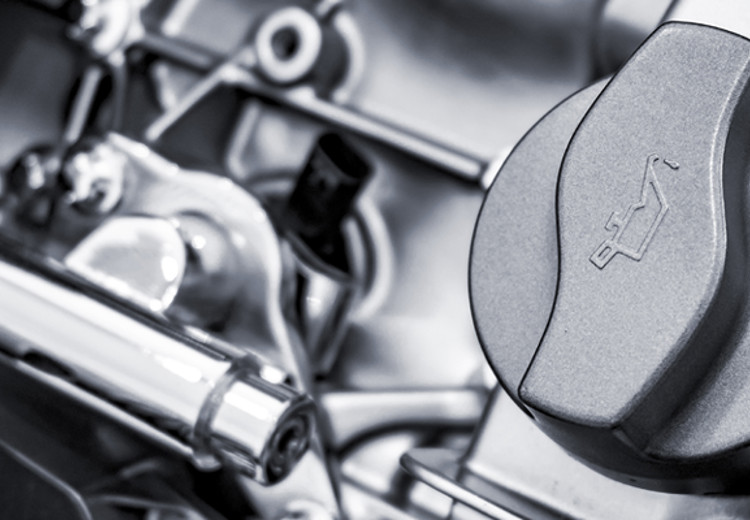
To meet industry performance requirements, today’s crankcase lubricants must be carefully developed using the most advanced chemistries. Tom Broomfield, Infineum Lubricant Deployment Technologist, explores the latest formulations trends and the advantages delivered by next generation viscosity modifiers.
The key drivers for change in today’s automotive industry are better fuel economy and lower tailpipe emissions. These trends significantly impact the development of crankcase lubricant formulations; particularly when they are combined with OEM demands for advanced wear protection, superior engine cleanliness and longer oil drain intervals.
Advanced additive components, including viscosity modifiers (VMs), are needed to support these trends, if they are to be achieved without sacrificing engine protection.
The main role of VMs is not, as might be expected, to increase oil thickness, but to increase the viscosity index so that the oil can demonstrate the characteristics of a multi-grade.
Two main performance attributes are measured to define the properties of VMs:
These properties are generally in competition with each other, which means that VMs with a high thickening efficiency tend to have less shear stability and vice versa. Other characteristics of VMs, defined by their chemical structure, which impact the performance of the lubricant, include base stock compatibility, oxidative stability, deposit control and soot handling. To adequately address the lubrication requirements of modern vehicles, advanced star and diblock hydrogenated styrene diene (HSD) VM polymers have been developed.
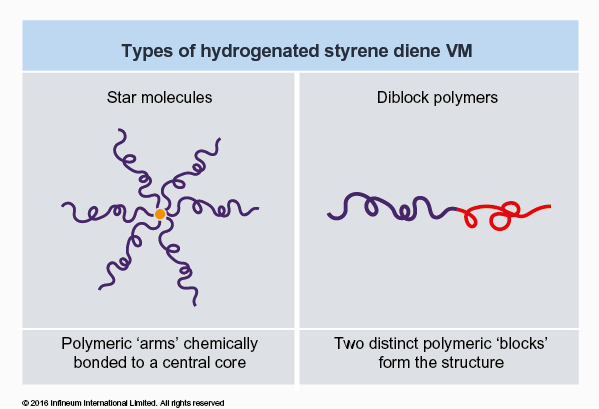
Both of these structures have good thickening efficiency and shear stability index. However, only the diblock is able to form self-assembled micelle structures when dissolved in base oil, which provides unique performance benefits in modern formulations.
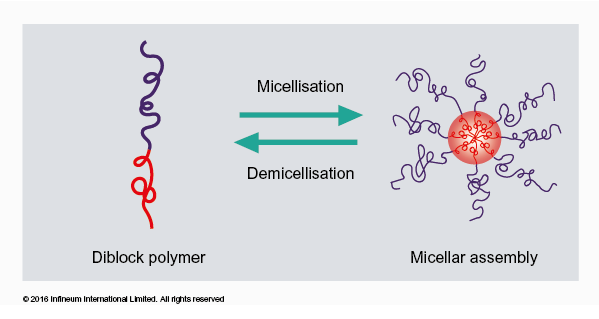
1) Thickening efficiency tuning. VMs generally have lower solubility and lower thickening efficiency in higher quality base stocks. However, the size of the blocks in the diblock polymer can be fine tuned to form micelles of optimal size, and thus thickening efficiency, at a desired shear stability index. This enables lubricants to be formulated in higher quality base stocks with minimum VM treat.
2) Superior shear stability. The micellar structures contribute more viscosity to the formulation than the individual diblock molecules, which means they have a higher relative thickening efficiency. However, when a shear force is applied the micelles can partially or fully disperse. Although the overall thickening efficiency is reduced, the molecules are not permanently sheared so that when the shear force is removed they self-assemble and provide their original contribution to viscosity.
3) Soot handling benefits. The soot handling benefits are a result of the affinity of the polystyrene block in the diblock molecules to the soot surface and the ability of the hydrogenated diene part of the molecule to stabilise the soot in solution.
As CO2 emissions reduction and improved efficiency become increasingly important, OEMs are looking for larger contributions to fuel economy from the lubricant. This means crankcase lubricants are increasingly being formulated in higher quality Group III base stocks and to lower viscosity grades. At the same time, the importance of soot handling has increased because it can contribute to fuel economy performance by preventing soot induced viscosity increase.
However, these additional requirements mean the use of advanced chemistries is essential to ensure the latest lubricants deliver the necessary level of fuel economy without sacrificing performance and protection. To support these demands, Infineum has been working to optimise the diblock HSD polymer blocks.
The polystyrene block has been redesigned so that the molecule is more soluble in higher quality base stocks when compared to the current diblock. This means the new diblock can be used in Group III formulations, while the conventional diblock is more suitable for use in lower quality base stocks. The polydiene block has also been optimised to provide a good balance between thickening efficiency and shear stability. These modifications have been carried out while ensuring the polymer retains the soot handling capabilities and excellent shear stability offered by current diblock technology.
To demonstrate the performance of the next generation VM, formulations using high quality base oils have been assessed in a number of industry tests and field trials.
First, in a heavy-duty diesel (HDD) SAE 10W-40 formulation in Group III base stocks the new diblock provided improved thickening, which resulted in a lower VM treat rate, increased use of heavier base stocks and better low temperature performance when compared to the current diblock.
To test the shear stability of the new diblock, two test oils were blended to the same KV100, one based on current diblock and the other on next generation diblock VMs. These were tested in the Kurt Orbahn (KO) shear stability rig, where the next generation diblock matched the performance of the current technology.
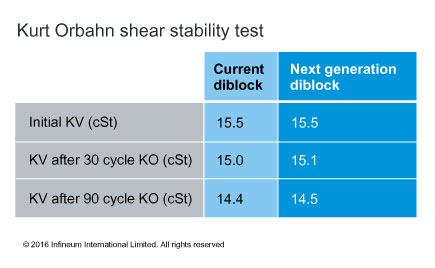 The next generation VM matched the shear stability performance of current diblock VMs
The next generation VM matched the shear stability performance of current diblock VMsThe shear stability of the next generation diblock vs. current diblock was also assessed in SAE 15W-40 oils in a Mack MP-8 field test. Viscosity loss for both oils over the oil drain interval was very similar, and both were above the minimum KV limit for SAE 15W-40 oils after 35,000 miles.
The Mack T11 test was used to assess the soot handling capability of HSD star, current diblock and next generation diblock VMs in SAE 10W-40 HDD formulations. While both diblocks outperformed the HSD star, the next generation VM also achieved this at a lower treat rate.
The excellent soot handling capabilities of the new diblock were also demonstrated in the PSA DV4 engine test in SAE 5W-40 passenger car formulations. Here, the next generation diblock gave equal or better soot handling performance when compared to a current diblock at an equal treat rate.
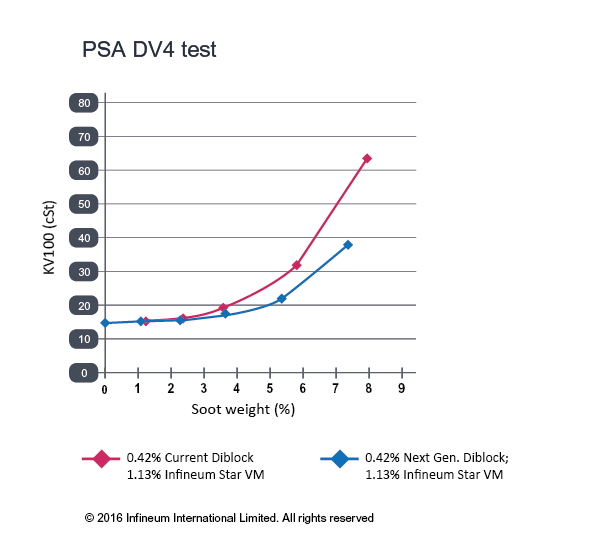 Next generation diblock retains soot credit in the PSA DV4 test
Next generation diblock retains soot credit in the PSA DV4 testThe diblock and star VMs have also been assessed in the PSA DV6 engine test, which is more representative of modern engines. Here, a similar improvement in soot induced viscosity increase control was observed for diblock vs. star VM.
The work undertaken by Infineum clearly demonstrates the advantages diblock HSD VMs can deliver to crankcase lubricants. The tuneable molecular structures, excellent soot handling capabilities and good shear stability mean they can provide significant benefits.
However, to meet evolving industry requirements, Infineum has optimised the HSD diblock chemistry so that it delivers superior performance in lower viscosity grade oils formulated using higher quality base stocks at lower polymer treat rate than current diblock technology. These advanced chemistries are being used to create lubricants that can help automotive OEMs as they work to address today’s key drivers for change.
Sign up to receive monthly updates via email